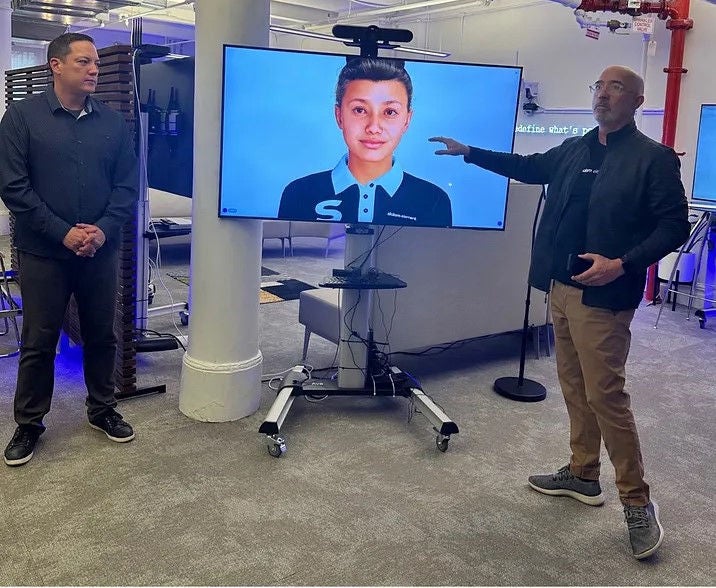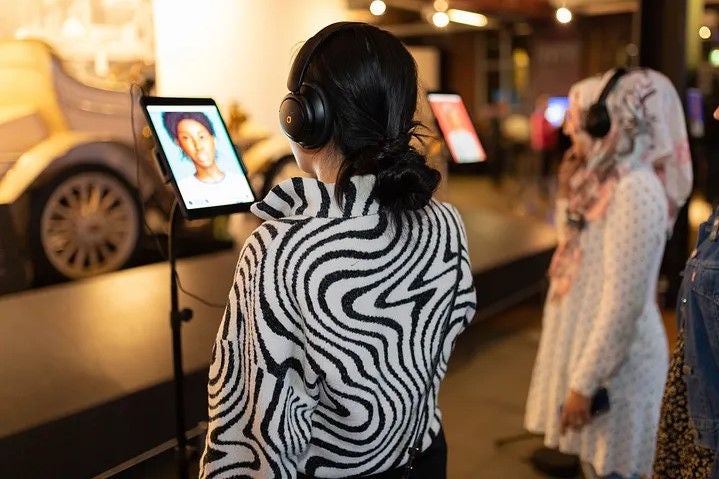Digital people: From gaming to global
 Exploring critical questions raised by the advances in digital people technologies
Exploring critical questions raised by the advances in digital people technologies
The evolution of digital people has been an intriguing journey that spans decades, reflecting our fascination with virtual representation and interaction. In the early days of computer science and gaming, avatars and non-player characters (NPCs) were the first attempts at incorporating digital representations into the virtual realm. Back in the ’80s, these simple characters barely scratched the surface of human likeness, offering limited interaction and customization. Yet, they paved the way for a future where the boundaries between virtual and physical realities would blur.
Fast forward to today and we find ourselves in an era where digital people are lifelike representations of us. Supported by some technological trickery, they can converse, learn, and perhaps even empathize. These digital people not only hold the promise of transforming customer service in industries such as healthcare, financial services, and entertainment by augmenting humans in the workforce, but also raise critical questions about our relationship with technology and the ethical implications of creating these digital beings.
From the rudimentary avatars and NPCs of the past to the digital people of the present, we have in some sense witnessed the convergence of our desire for connection and the rapid advancements in artificial intelligence, computer graphics, and natural language processing.
The technological trickery
From a consumer’s perspective, they simply get to interact with an extremely lifelike chatbot. It looks fairly human-like, speaks like a human and makes movements a human would, like blinking and gesturing to information on screen. When skillfully executed, these interactions belie the intense amount of work required. The creation of a digital-person experience involves both front-end and back-end components, which work together to generate images, speech, and animation. These include voice and camera capture, the rendering of the digital person in the cloud using a 3D engine, browser-based video streaming, and both speech-to-text (STT) and text-to-speech (TTS) translation. Computer vision is used to determine emotional sentiment, and natural language processing (NLP) is employed to analyze intent and respond accordingly.
The non-character players
There are a few key players in this game, including tech giants like Nvidia, Amazon, Google, and Microsoft. These companies have invested significant resources into developing many of the cloud services used to enable a digital person experience. While the cloud services remain invisible to the end user, they create the foundation on which the experience is built.
If the big tech firms build the digital person foundation, digital person software providers such as Uneeq, Synesthesia, and Slalom partner Soul Machines construct the façade. They—along with advanced research institutions—are pushing the boundaries of what is possible with digital person technology, each iteration more humanlike than the last.
Partnering to prioritize accessibility
 By combining models of physiology, cognition, and emotion, Soul Machines has created a new form of biologically inspired AI.
By combining models of physiology, cognition, and emotion, Soul Machines has created a new form of biologically inspired AI.
And what is a façade or foundation without a building? The creation of an impactful digital person experience requires expertise in conversational design, experience design, data and insights, privacy, systems architecture, and quality assurance. The absence of any one of these elements can turn a compelling customer experience into a disaster, or worse: mediocrity.
Digital people at large
Recent adoption of generative AI tools such as ChatGPT and Midjourney by the public have sparked an impressively wide range of innovative use cases. As industries explore opportunities to integrate digital person technology into their business, we see a similar trend taking shape—the ways in which digital people can intersect with our lives are extensive, limited only by our own creativity, and with much more territory yet to be explored. Soon, simply improving the customer experience won’t cut it—we’re on the precipice of a step-change in customer expectations.
As the top leaders in tech and design begin to place AI at the center of their digital offerings, the bar of customer expectations will undoubtedly rise in turn. Customers will gravitate towards the brands that offer simple, innovative, and engaging ways to interact, allowing them to transact and get things done in a more human-centric way than ever before.
 Visitors engaging with Soul Machine’s digital people at Slalom’s Manchester, UK Connect event.
Visitors engaging with Soul Machine’s digital people at Slalom’s Manchester, UK Connect event.
Today, digital people are helping customers realize unmet needs in clever and unexpected ways. For example, a digital skincare consultant in Asia is a popular choice for customers, with many reporting feeling more comfortable speaking with the digital consultant about blemishes and skincare routines than an actual human, driving a significant uptick in sales. In the DFW airport, you can easily locate the nearest burger joint via a quick chat with Iris, a digital concierge. And within financial services, digital people are being explored to augment (not replace) traditional human interactions, such as coaching customers on how to get the most out of an upcoming consultation with a financial advisor.
The evolution of human-centered tech
Driven by the proliferation of human-centered design philosophy in tech, our day-to-day digital interactions have become progressively more natural for quite some time. A prime example is the evolution of user interface (UI) navigation. Just over twenty years ago, the iPod click wheel reimagined the UI experience into something natural and intuitive, immediately outpacing existing MP3 players that demanded a clunky sequence of precisely pressed buttons. Soon after, this evolved into touchscreens, voice commands and even hand gestures, significantly shortening the learning and adoption curve.
Today, UI navigation by physical button can feel burdensome and archaic. We’re seeing this evolve into NLP, where these interactions are becoming as convenient—albeit unsettling—as holding a conversation with another human. Layering in a visual personification of the machine into those conversations is the next logical step along this trendline, and it’s happening right now.
As with many new technologies, workers worry about being replaced and consumers worry about privacy and ethics. Where, then, does Slalom’s fiercely human ethos fit into the potential widespread adoption of digital people? We believe that digital person technology should augment the human workload, and that the replacement of jobs or processes creates an opportunity upskilling and growth.
Digital people can even provide relief to those in high-pressure or emotionally draining jobs. For example, Slalom is working with a loan servicing company to launch digital people in the collections space. Whereas a human may experience burnout or even trauma in such jobs, a digital person has an endless supply of empathy. As in the skin care example, the individual on the other end of the phone may feel more comfortable speaking with someone who does not have capacity for negative judgment.
Now what?
While information has its own value, we’d also like to leave you with some concrete steps to begin exploring digital people and incorporate them into your work, life, and future.
Next best actions
- Seek out a digital person interaction, such as on the Soul Machines, Synesthesia, or Uneeq websites.
- Review your tech stack to discern digital person readiness.
If, then, else
- If: Consider use cases in your personal and professional workflows
- Then: How might you modify your research, creative, or engineering workflows to include digital people as a step in the process? What would be the value add from a camera- and microphone-on, human-like interaction?
- Else: How else would you use digital people? How might they be used to augment the individuals in your workforce, or even provide relief in high-stress customer interactions? For example, Slalom is working with our customers to use digital people in financial services to provide gamified education to potential investors.
Check your bias
What are the fears you have about this technology? AI-enabled digital people taking over, loss of jobs or privacy? (All fair game.) What information are you consuming? What are the objective facts, and what is confirming your beliefs or fueling your fears?
In summary, don’t let first impressions keep you from using technology to build better tomorrows for all.
This blog post was originally published here.
